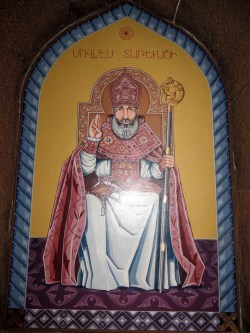The “dark centuries” in Armenian history (fifteenth-seventeenth centuries), when the country was a battlefield between Turkmens, Ottoman Turks, and Persians, also coincided with a period of decline in the Catholicosate of Holy Echmiadzin due to the absence of a stable ecclesiastic authority, the lack of spiritual education of most clergymen, and the empty monasteries. This decadence in the 1441-1629 period, compounded by quarrels between ambitious churchmen who fought to occupy the Holy See, came to an end thanks to the activities and the short reign of Catholicos Movses III.
Movses Datevatsi was born in 1578 in the village of Khodanan, in the region of Siunik, where he spent his childhood and showed a precocious love for the Church. He frequented the nearby monastery of Datev, where he had a relative, Archbishop Hovhannes, who consecrated him celibate priest in 1593. Becoming a member of the congregation of Datev, he is known by the surname Datevatsi, although we often find him under the surnames Siunetsi or Khodanantsi.
He later departed to Amida (Diyarbekir), where he was a student of Srapion Edesatsi and then Khachatur Gesaratsi until 1606. In 1610 he went to Jerusalem, where he became sacristan of the Church of Holy Sepulchre. The next year we find him in Constantinople, where his teacher Khachatur Gesaratsi had become Armenian Patriarch. The latter gave him the rank of vartabed. Movses returned to Datev in 1613 and settled in the nearby Great anabad of Siunik; the name anabad (“desert”) was applied to centers of hermits located near monasteries. He devoted himself to preaching the need to live according to the tenets of Christianism.
Around 1620 he preached in the church of Katoghike in Yerevan, rebuilt the anabad of Apostle St. Anania in the northern area of the city, put order in the churches and monasteries of the province of Ayrarat, and reopened the monastic schools of Hovhannavank and Saghmosavank. He was consecrated bishop in 1623 and traveled to Ispahan, the capital of Persia, in 1626. Shah Abbas I (1587-1628) attended Bishop Movses’ ceremony of Armenian Christmas in January 1627. He was deeply impressed and promised a prize, accepting Movses Datevatsi’s request to become sacristan at the monastery of Holy Echmiadzin and obtain a decree authorizing the renovation of the monastery. The renovation started in June 1627 and included the monastery, the residence of the Catholicos, the auxiliary constructions, and the walls. Movses Datevatsi was “elected Catholicos” at the beginning of 1628 and officially consecrated on January 13, 1629.
The new shah Safi (1629-1642) issued decrees confirming Movses III’s accession to the throne of Catholicos and waiving the debts of the monastery of Holy Echmiadzin. During his short pontificate, Catholicos Movses paid off all remaining debts, opened new schools and monasteries, and organized monastic life.
Catholicos Movses III passed away on May 14, 1632, in the anabad of Apostle St. Anania, in Yerevan. He was buried in the local cemetery of Kozern, in the neighborhood of Kond, near the church of Surp Zoravor.
